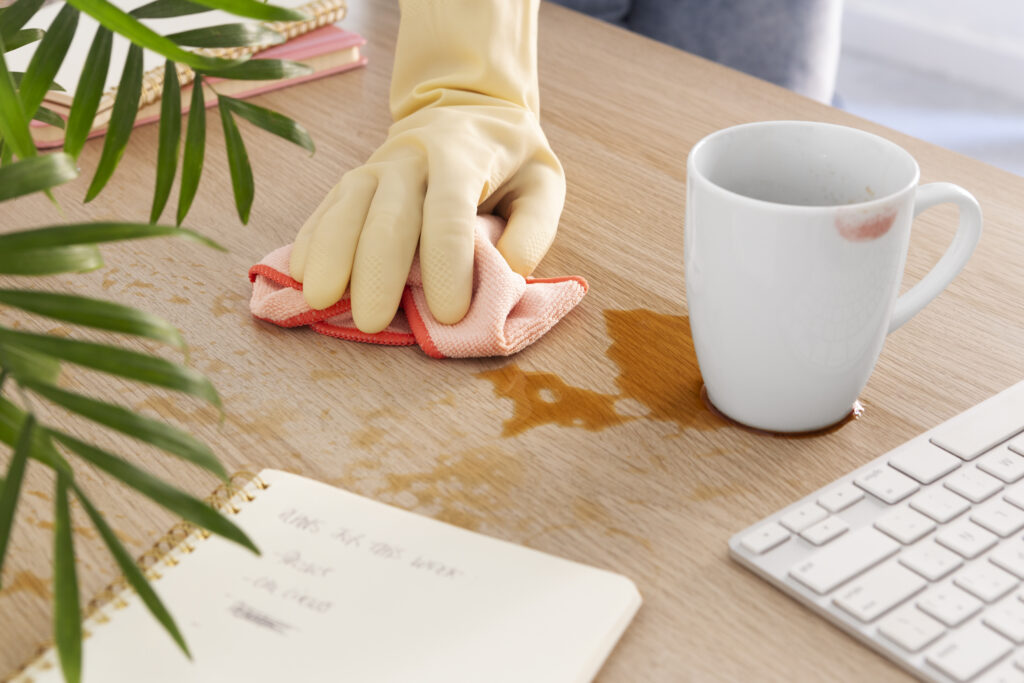Turmeric is a spice that is commonly used in cooking and is known for its vibrant yellow color. While it adds a beautiful hue to dishes, it can also leave behind stubborn stains on clothing, countertops, and other surfaces. Removing turmeric stains can be a challenge, but with the right techniques, it is possible to get rid of them completely.
One of the most important things to keep in mind when trying to remove turmeric stains is to act quickly. The longer the stain is left untreated, the more difficult it will be to remove. There are a variety of methods that can be used to remove turmeric stains, including using household items like vinegar and baking soda, as well as commercial stain removers.
It is important to note that the effectiveness of different stain removal methods may vary depending on the type of surface the stain is on. For example, a stain on fabric may require a different treatment than a stain on a countertop. With the right approach and a little bit of patience, however, it is possible to remove even the most stubborn turmeric stains.
Understanding Turmeric Stains
Turmeric is a bright yellow spice used in cooking and as a natural dye. While it adds flavor and color to dishes, it can also leave stubborn stains on clothing, skin, and surfaces. Understanding the properties of turmeric can help in effectively removing its stains.
Turmeric contains a compound called curcumin, which is responsible for its vibrant color. Curcumin is a natural dye that binds to fabrics and surfaces, making it difficult to remove. The longer the turmeric stain is left untreated, the harder it is to remove.
Turmeric stains are particularly difficult to remove from clothing made of natural fibers, such as cotton and linen. Synthetic fabrics, such as polyester and nylon, are less prone to staining. Turmeric stains on skin are also common, especially when handling the spice in powder form.
When attempting to remove turmeric stains, it is important to avoid using hot water or bleach, as this can set the stain and make it permanent. Instead, use cool water and gentle cleaning agents, such as dish soap or white vinegar. Overall, understanding the properties of turmeric and how it behaves on different surfaces can aid in effectively removing its stains.
Pre-Treatment Steps
Before attempting to remove turmeric stains, there are a few pre-treatment steps that should be taken to increase the likelihood of success.
Blotting the Stain
The first step in removing turmeric stains is to blot the affected area with a clean, dry cloth or paper towel. This will help to remove any excess turmeric powder or paste that may be sitting on top of the fabric. Be sure to blot gently, as rubbing the stain can cause it to spread and become more difficult to remove.
Rinsing With Cold Water
After blotting the stain, the next step is to rinse the affected area with cold water. This will help to remove any remaining turmeric powder or paste, as well as any loose fibers or dirt that may be present. It is important to use cold water, as hot water can set the stain and make it more difficult to remove.
To rinse the stain, hold the fabric under a stream of cold water, or immerse it in a bowl or sink filled with cold water. Gently agitate the fabric to help loosen any remaining particles, then rinse thoroughly until the water runs clear.
By taking these pre-treatment steps, you can increase the effectiveness of your stain removal efforts and improve your chances of success.
Using Household Items
There are several household items that can help remove turmeric stains from clothes and other surfaces. Here are some of the most effective methods:
Lemon Juice Method
Lemon juice is a natural bleaching agent that can help remove turmeric stains. Here’s how to use it:
- Squeeze fresh lemon juice onto the stain.
- Allow the lemon juice to sit on the stain for 5-10 minutes.
- Rinse the stained area with cold water.
- Repeat the process until the stain is gone.
Baking Soda Method
Baking soda is another effective household item that can help remove turmeric stains. Here’s how to use it:
- Mix baking soda with water to create a paste.
- Apply the paste directly to the stain.
- Allow the paste to sit on the stain for 30 minutes.
- Rinse the stained area with cold water.
- Repeat the process until the stain is gone.
Vinegar Method
Vinegar is a versatile household item that can be used to clean a variety of surfaces, including turmeric stains. Here’s how to use it:
- Mix equal parts vinegar and water.
- Soak the stained area in the vinegar solution for 30 minutes.
- Rinse the stained area with cold water.
- Repeat the process until the stain is gone.
It’s important to note that these methods may not work on all types of fabrics and surfaces. Always test a small, inconspicuous area first before attempting to remove the stain.
Commercial Stain Removers
Choosing the Right Product
When it comes to removing turmeric stains, there are a variety of commercial stain removers available in the market. It is important to choose the right product that is specifically designed to remove turmeric stains.
Before purchasing a stain remover, one should consider the type of fabric or surface that needs to be cleaned. Some stain removers may not be suitable for delicate fabrics or certain types of surfaces. It is also important to read the label and follow the instructions carefully to avoid any damage to the fabric or surface.
Application Process
The application process for commercial stain removers may vary depending on the product. However, there are some general guidelines that can be followed:
- Apply the stain remover directly to the affected area.
- Allow the product to sit for a few minutes to penetrate the stain.
- Gently rub the stain with a soft-bristled brush or cloth.
- Rinse the fabric or surface thoroughly with water.
- Check the stain to see if it has been completely removed. If not, repeat the process or try a different product.
It is important to note that some stain removers may require additional steps, such as soaking the fabric in water or washing it in the washing machine. Always follow the instructions provided on the label of the product.
Overall, commercial stain removers can be effective in removing turmeric stains. However, it is important to choose the right product and follow the instructions carefully to avoid any damage to the fabric or surface.
Washing and Drying
After following the initial steps for removing turmeric stains, it is time to wash and dry the affected area. Here are a few tips to ensure that the stain is completely removed:
- Wash the fabric or surface thoroughly with a mild detergent and warm water. Avoid using hot water as it can set the stain.
- If the stain is particularly stubborn, try using a stain remover or a solution of equal parts vinegar and water. Apply the solution to the stain and let it sit for a few minutes before washing.
- If the stained item is delicate or cannot be washed, try using a dry cleaning solvent or taking it to a professional cleaner.
- Once the stain has been removed, rinse the item thoroughly with cold water to remove any remaining detergent or solution.
- Finally, hang or lay the item flat to dry. Avoid using a dryer as the heat can set any remaining stain.
By following these simple steps, you can effectively remove turmeric stains from a variety of fabrics and surfaces.
Preventing Future Stains
Preventing turmeric stains in the first place is the best way to avoid the hassle of removing them. Here are a few tips to help prevent future stains:
- Wear gloves: When handling turmeric, wear gloves to prevent the spice from staining your hands.
- Use non-stick cookware: Cooking with non-stick cookware can help prevent turmeric from sticking and staining the cookware.
- Clean up spills immediately: If a turmeric spill occurs, clean it up immediately to prevent it from setting into the surface and causing a stain.
- Use a protective barrier: Placing a protective barrier, such as a paper towel or plastic wrap, between the turmeric and the surface can help prevent staining.
- Be cautious with clothing: When cooking with turmeric, be cautious with clothing as it can easily stain fabric. Wearing an apron can help protect clothing from turmeric stains.
By following these tips, you can prevent turmeric stains and avoid the hassle of removing them in the future.
Frequently Asked Questions
How can I remove turmeric stains from my couch?
To remove turmeric stains from your couch, you can use a mixture of dish soap and warm water. Mix a few drops of dish soap with warm water and apply the solution to the stain. Let it sit for a few minutes, then blot the area with a clean cloth. Repeat the process until the stain is gone.
What is the best way to remove turmeric stains from jeans?
To remove turmeric stains from jeans, you can use a mixture of baking soda and water. Mix baking soda with a small amount of water to form a paste. Apply the paste to the stain and let it sit for a few minutes. Then, rinse the area with cold water and wash the jeans as usual.
How can I remove turmeric stains from my carpet?
To remove turmeric stains from your carpet, you can use a mixture of vinegar and water. Mix equal parts of vinegar and water and apply the solution to the stain. Let it sit for a few minutes, then blot the area with a clean cloth. Repeat the process until the stain is gone.
How do I remove turmeric stains from wood?
To remove turmeric stains from wood, you can use a mixture of baking soda and water. Mix baking soda with a small amount of water to form a paste. Apply the paste to the stain and let it sit for a few minutes. Then, rinse the area with cold water and dry it with a clean cloth.
Are turmeric stains permanent on clothes?
Turmeric stains can be difficult to remove, but they are not necessarily permanent. With the right cleaning solution and technique, you can remove turmeric stains from clothes





